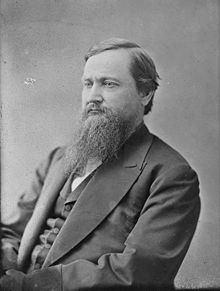Mark H. Dunnell
Mark H. Dunnell | |
|---|---|
 | |
| US House of Representatives | |
| U.S. Representative fromMinnesota's 1st congressional district | |
| In office 1889–1891 | |
| Preceded by | Thomas Wilson |
| Succeeded by | William H. Harries |
| U.S. Representative fromMinnesota's 1st congressional district | |
| In office 1871–1883 | |
| Preceded by | Morton S. Wilkinson |
| Succeeded by | Milo White |
| Member of theMaine Senate from the 13th district Hebron, County of Oxford (1855) | |
| Member of theMaine House of Representatives from the 13th district Hebron, County of Oxford. 33rd Session (1854) | |
| Personal details | |
| Born | Mark Hill Dunnell February 7, 1823 Buxton,York County,Maine |
| Died | September 8, 1904(aged 81) Owatonna,Minnesota,U.S. |
| Political party | Republican |
| Military service | |
| Allegiance | •Union |
| Branch/service | Union Army |
| Battles/wars | American Civil War |
Mark Hill Dunnell(July 2, 1823 – August 9, 1904) was a member of theU.S. House of RepresentativesfromMinnesotafrom 1871 to 1883 and from 1889 to 1891.
Biography[edit]
Born inBuxton,York County,Maine,he completed preparatory studies, and was graduated from Waterville College (nowColby College),Waterville, Maine,in 1849. For five years he was principal of the Norway andHebron Academies.He became a member of theMaine House of Representativesin 1854 and served in theMaine Senatein 1855.[1]He served as state superintendent of common schools in 1855 and 1857 – 1859. He was a delegate to theRepublican National Conventionin 1856. He studied law, was admitted to the bar in 1856 and commenced practice inPortland, Maine,in 1860. He entered theUnion Armyas colonel of the5th Maine Volunteer Infantry Regiment,May 6, 1861, but mustered out on August 31, 1861. He served as United States consul atVera Cruz,Mexico,in 1861 and 1862.

Dunnell moved to Minnesota in 1865, settling first inWinona,in 1865, and moving toOwatonnain 1867. He became a member of theMinnesota House of Representativesin 1867 and served as state superintendent of public instruction from April 2, 1867, to August 1870, when he resigned.
He was elected as aRepublicanto the42nd,43rd,44th,45th,46th,and47th Congresses,(March 4, 1871 – March 3, 1883); unsuccessful candidate for Speaker of the Forty-Seventh Congress; was not a candidate for renomination in 1882; unsuccessful candidate for election to theUnited States Senatein 1883; elected to the51st Congress,(March 4, 1889 – March 3, 1891); unsuccessful candidate for reelection in 1890 to the52nd Congress;delegate to the Republican National Convention in 1892.
He was one of the founders and a member of the board of trustees of Minnesota Academy, a high school for boys and girls in Owatonna, being renamedPillsbury Academyin 1887, and becoming a military academy for high school boys only in 1920.
Dunnell died in Owatonna in 1904 and is buried in Forest Hill Cemetery. He is the namesake of the city ofDunnell, Minnesota.[2]
References[edit]
- ^Documents Printed by order of the Legislature of the State of Maine during its Session A.D. 1855.Augusta, Maine: Stevens and Blaine, Printers to the State. 1855. p. 2.
- ^Upham, Warren (1920).Minnesota Geographic Names: Their Origin and Historic Significance.Minnesota Historical Society. p.333.
- United States Congress."Mark H. Dunnell (id: D000555)".Biographical Directory of the United States Congress.Retrieved on 2008-10-18
- 1823 births
- 1904 deaths
- Colby College alumni
- Members of the Minnesota House of Representatives
- Republican Party members of the Maine House of Representatives
- Republican Party Maine state senators
- Maine lawyers
- Minnesota lawyers
- People of Maine in the American Civil War
- People from Buxton, Maine
- Union Army colonels
- Republican Party members of the United States House of Representatives from Minnesota
- 19th-century American legislators
- People from Owatonna, Minnesota
- Military personnel from Minnesota
- 19th-century Minnesota politicians
